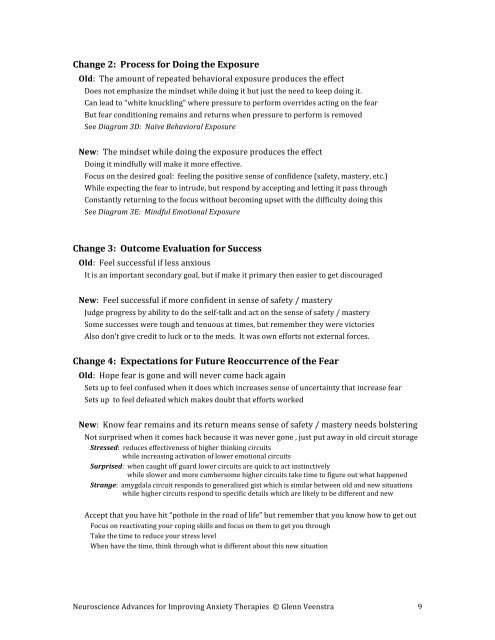Veenstra 170 - Anxiety Disorders Association of America
Veenstra 170 - Anxiety Disorders Association of America
Veenstra 170 - Anxiety Disorders Association of America
You also want an ePaper? Increase the reach of your titles
YUMPU automatically turns print PDFs into web optimized ePapers that Google loves.
Change 2: Process for Doing the Exposure<br />
Old: The amount <strong>of</strong> repeated behavioral exposure produces the effect<br />
Does not emphasize the mindset while doing it but just the need to keep doing it.<br />
Can lead to “white knuckling” where pressure to perform overrides acting on the fear<br />
But fear conditioning remains and returns when pressure to perform is removed<br />
See Diagram 3D: Naïve Behavioral Exposure<br />
New: The mindset while doing the exposure produces the effect<br />
Doing it mindfully will make it more effective.<br />
Focus on the desired goal: feeling the positive sense <strong>of</strong> confidence (safety, mastery, etc.)<br />
While expecting the fear to intrude, but respond by accepting and letting it pass through<br />
Constantly returning to the focus without becoming upset with the difficulty doing this<br />
See Diagram 3E: Mindful Emotional Exposure<br />
Change 3: Outcome Evaluation for Success<br />
Old: Feel successful if less anxious<br />
It is an important secondary goal, but if make it primary then easier to get discouraged<br />
New: Feel successful if more confident in sense <strong>of</strong> safety / mastery<br />
Judge progress by ability to do the self-‐talk and act on the sense <strong>of</strong> safety / mastery<br />
Some successes were tough and tenuous at times, but remember they were victories<br />
Also don’t give credit to luck or to the meds. It was own efforts not external forces.<br />
Change 4: Expectations for Future Reoccurrence <strong>of</strong> the Fear<br />
Old: Hope fear is gone and will never come back again<br />
Sets up to feel confused when it does which increases sense <strong>of</strong> uncertainty that increase fear<br />
Sets up to feel defeated which makes doubt that efforts worked<br />
New: Know fear remains and its return means sense <strong>of</strong> safety / mastery needs bolstering<br />
Not surprised when it comes back because it was never gone , just put away in old circuit storage<br />
Stressed: reduces effectiveness <strong>of</strong> higher thinking circuits<br />
while increasing activation <strong>of</strong> lower emotional circuits<br />
Surprised: when caught <strong>of</strong>f guard lower circuits are quick to act instinctively<br />
while slower and more cumbersome higher circuits take time to figure out what happened<br />
Strange: amygdala circuit responds to generalized gist which is similar between old and new situations<br />
while higher circuits respond to specific details which are likely to be different and new<br />
Accept that you have hit “pothole in the road <strong>of</strong> life” but remember that you know how to get out<br />
Focus on reactivating your coping skills and focus on them to get you through<br />
Take the time to reduce your stress level<br />
When have the time, think through what is different about this new situation<br />
Neuroscience Advances for Improving <strong>Anxiety</strong> Therapies © Glenn <strong>Veenstra</strong> 9


